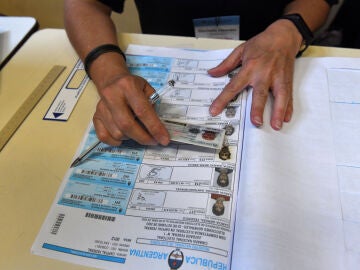
Anyone who has participated at any time in a electoral process knows the term ‘scrutiny’, since it does not matter what voting system exists: scrutiny is, after all, the process through which the votes of the people who have participated in a specific election are counted. But it doesn’t work the same way in all countries. On October 22, they were celebrated in Argentina general elections to elect the president and although the resultswe will have to wait for a second round to see who of the two main candidates They manage to gain the majority of society’s support to finally gain access to the Casa Rosada.
Now, the results that are known so far are known as provisional or provisional results, and it is Tuesday, October 24, 48 hours after the elections, when The final scrutiny process begins in Argentina. During the provisional election, the votes from each table are counted, in the same way as is done in an election in Spain, information that is transmitted to the Electoral Justice and the National Electoral Directorate. However, the provisional results do not cover the total number of tables, because there is always a small portion of telegrams that are not sent, have manufacturing errors or are left uncompleted.
In fact, the provisional scrutiny of the electoral results in Argentina have no legal validity nor does it serve to proclaim the elected representatives, but only has the function of informing citizens about how the vote went. We must wait for the final scrutiny to really know the official results of the elections, and this begins 48 hours after election day, on Tuesday, October 28.
How the final scrutiny is done in Argentina
Instead of being done by the members of the polling stations, the final scrutiny of the electoral results in Argentina is carried out by the National Electoral Justice. It is carried out based on the scrutiny records of each table, but in this case it does cover all the tables enabled for the electoral process.
All groups that intervene in the elections can appoint prosecutors with the right to attend the counting of the votes to examine all the documentation. As a general rule, the National Electoral Code – the Argentine equivalent of the Spanish Electoral Law or LOREG – does not impose a deadline to complete the counting of the ballots, but it does in the case of presidential elections, as is the case, therefore that The final results must be known no later than November 3given that you have a period of 10 calendar days to carry out the process.
In this final scrutiny, the minutes are analyzed table by table and it is verified, among other things, the possibility that the record has been adulterated, if it has defects in form or if the number of voters coincides with the number of envelopes sent by the authority of the table. It is because of these small details that the provisional and final scrutiny are not always the same.
Does the final count change the results of the election?
In this circumstance, it is worth asking whether the final scrutiny process could change the direction of the results of elections such as those held this October 22. The truth is that the differences between the provisional and the final have been minimal throughout the history of Argentine democracy and except in very close elections, with a very tight difference in votes between two political forces, the final scrutiny does not usually change the final result.
In the case of the presidential elections, the results are not close at all so, vote up, vote down, the results of the final count are expected to be very similar, with Sergio Massa ahead of Javier Milei.
Source: Lasexta
Ricardo is a renowned author and journalist, known for his exceptional writing on top-news stories. He currently works as a writer at the 247 News Agency, where he is known for his ability to deliver breaking news and insightful analysis on the most pressing issues of the day.











